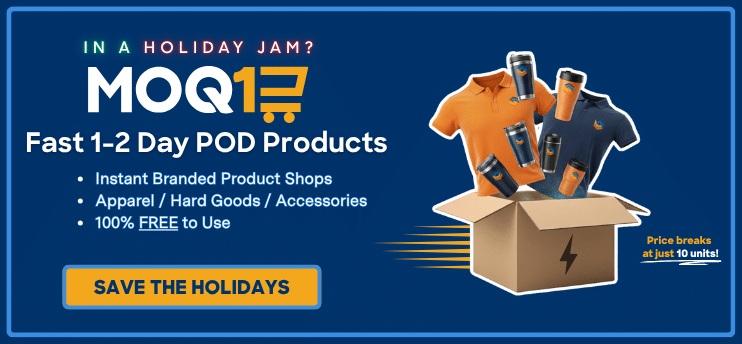Promo’s growth has slowed in 2025, and according to the data, clients and distributors are making new requests amid that slowdown.
- In May and June, the promotional products industry’s revenue only grew by 0.37% compared to the same months in 2024, which continued a downward trend for the year and reached a low for any point in 2024 or 2025.
There are plenty of internal and external factors for slowed growth in the promo industry (as well as many other global industries), but one topic that has been hard for any firm to avoid for all of 2025 has been tariffs. The implementation of tariffs has put a financial strain on promo firms, and the uncertainty surrounding threatened tariffs (essentially shifting since March) has hampered long-term planning.
- Just as likely are the ramifications that tariff-related factors are having on client orders and how they might be changing during this period.
“Tariff pressure is reshaping global sourcing in 2025,” says Alok Bhat, market economist and PPAI’s research & public affairs lead.
RELATED: PPAI Research: Distributors Expanding Supplier Base Amid Volatility
In order to draw out further data, PPAI Research surveyed PPAI 100 companies on the observations and expectations they are noting in a post-tariff environment. To include both perspectives, this survey takes a look at:
- Suppliers’ reporting on what they are seeing in terms of distributor expectations
- Distributors’ reporting on what they are observing from client demand and requests.

Alok Bhat
Market Economist, Research & Public Affairs Lead, PPAI
What Suppliers Are Reporting In Terms Of Distributor Expectation
There seems to be a clear cause and effect when it comes to tariffs and what distributors are asking of their supplier partners.
- 75% of PPAI 100 suppliers report an increased demand for domestic or nearshore availability.
This is no surprise, as implemented or threatened tariffs have given distributors and clients good reason to get ahead of rising costs and consider domestic options. Still, according to some suppliers, because the U.S. doesn’t have the manufacturing infrastructure that many overseas countries have, it’s debatable whether these initial demands are always leading to stateside action.
“While there seems to be increased talk about ‘made-in-USA,’ [we’re] not seeing significant change in buying patterns to ‘made-in-USA,'” one PPAI 100 supplier said.
PPAI 100 Supplier
Additionally, suppliers are reporting a trend of (and in some cases pressure toward) smaller, lower-commitment orders as they navigate tariff uncertainty.
- 37.5% of suppliers cite a pressure for shorter lead times than they had previously been accustomed to. Likewise, 35.7% reported an increase in event-driven or rush programs.
- 23.8% claim there is more interest from distributors in product trials or smaller orders.
“These trends reflect a cautious, tactical mindset, where flexibility and speed outweigh volume or long-term planning,” Bhat says.
According to Jodie Schillinger, executive vice president of Maple Ridge Farms, PPAI 100’s No. 49 supplier, we’ve entered a period when every phase of the promo supply chain is potentially feeling the stress of tariff-related factors. In such a scenario, a supplier doesn’t have much choice but to see a distributor’s requests as an opportunity to stand out.
RELATED: PPAI Research: Two Thirds Of Suppliers Expanding Their Sourcing Footprint
“Post-tariff volatility really has required prioritizing client needs,” Schillinger said. “It has given a lot of firms the opportunity to flex their agility and resilience. That’s not anything new, necessarily, but things like pricing and speed now dominate conversations.”
Along with all of this, order sizes are contracting, with 58.2% reporting smaller average distributor orders, though only 4.7% report that decline as significant.
What Distributors Are Reporting From Clients In Terms Of Expectations
Distributors are reporting a pullback on premium and imported goods. According to PPAI 100 distributors, there’s been a notable reduction in high demand for high-ticket, imported or one-time-use items.
Instead, the top three categories driving distributor client demand in 2025 have been:
- Wearables/apparel (93.9%)
- Drinkware (61.2%)
- Bags/travel gear (38.8%)
It seems that pricing expectation has not been uniform for distributor clients in 2025, and that has had a trickle-down effect on expectations versus reality when it comes to demands.
- 51.9% of distributors report mixed client price expectations. This includes variances by industry, program type or urgency.
- 25.9% note rising cost consciousness among their clients.
- While 34% of distributors say their clients ask for eco sustainability certifications and 53.2% say they want made-in-USA or origin-specific products, only 7.4% of distributors are reporting that clients are showing tolerance for premium pricing tied to ESG, quality or origin.
“These responses reflect a fragmented pricing environment, with fluid value perceptions and continued client caution,” Bhat says.
With direct access to clients, distributors have a unique perspective on where the future of the industry is headed during volatile times, which tend to accelerate change.
- PPAI 100 distributors anticipated innovation in AI-enabled products, print-on demand models and webstore-driven gifting.
- Customization continues to be an asset that can help firms succeed if they find room to innovate within.
- Sustainability trends remain talking points, even if there are sometimes hangups with pricing. Exploring options within is becoming a necessity more than an advantage.
One PPAI 100 distributor reported that clients are bringing up activations more and more as an opportunity to squeeze the most out of their promo budget.
PPAI 100 Distributor
“We believe we will continue to see a focus on experiential and activations leveraging promotional products,” the distributor said. “This has been a major trend over the past few years, and we are seeing more and more brands following suit.”


